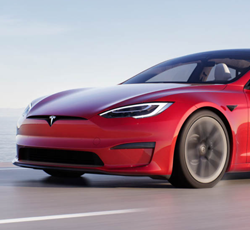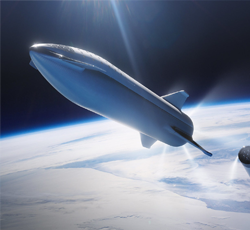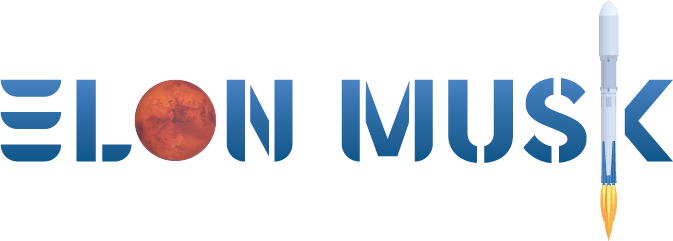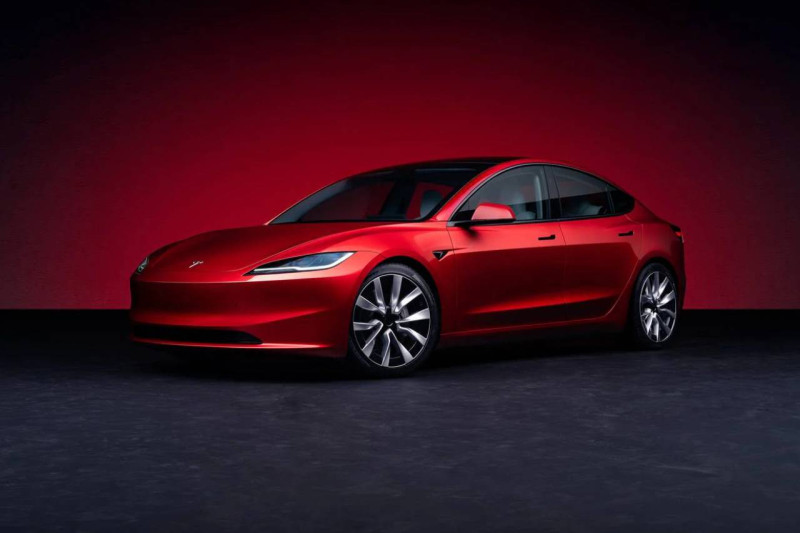
SpaceX Starlink and Samsung Develop AI-powered Modem
- by NextBigFuture
- Oct 25, 2025
- 0 Comments
- 0 Likes Flag 0 Of 5

Brian Wang
Recent announcements highlight Samsung’s development of an AI-powered modem chip designed to enable direct satellite-to-device (D2D) connectivity with SpaceX’s Starlink constellation. This chip uses AI to optimize signal processing, beamforming, and interference management, allowing unmodified smartphones and devices to connect to low-Earth orbit (LEO) satellites at gigabit speeds—even indoors or through obstacles like buildings and foliage. The tech is positioned as a precursor to non-terrestrial networks (NTN) for 6G, which could eliminate the need for traditional cell towers in remote or urban dead zones.
eports that SpaceX has tasked Samsung with building this AI-boosted modem for space-based 6G, revolutionizing D2D links by handling high-latency satellite signals with low power consumption.
A presentation purportedly shared by Samsung execs on Thursday showed that the new Exynos modem can improve beam identification and channel prediction performance “by 55 and 42 times, respectively,” compared with current models, writes the Korean source publication. Obviously, this is enough to enable the real-time tuning capabilities that such modems currently struggle with.
KED Global (Oct 22, 2025): Samsung is in talks to supply components for SpaceX’s 6G NTN, with the modem chip enabling seamless integration into Galaxy devices for global coverage. Samsung Electronics Co., the world’s top memory chipmaker, is developing an artificial intelligence modem chip designed for satellite communications, targeting SpaceX’s Starlink network as part of its next-generation non-terrestrial 6G ambitions. A senior executive in Samsung’s semiconductor division recently met with SpaceX officials to share technical details and development progress on the chip, according to people familiar with the matter on Thursday. The Korea Economic Daily show that Samsung’s System LSI division is developing a new Exynos modem that’s integrated with an AI accelerator, called a neural processing unit (NPU).
Existing chipsets have a limited capability to track fast-moving satellites and maintain beam alignment, but the AI-enhanced modem is designed to predict satellite trajectories and optimize signal links in real time, sources said.
AI for adaptive modulation could achieve 1 Gbps+ indoors via Starlink’s V3 satellites. SammyGuru (Oct 24, 2025): Details how the chips will power direct LEO connections, potentially debuting in Samsung’s 2026 flagships.
SpaceX’s V3 satellites, unveiled in October 2025, are pivotal here. These next-gen birds are 3x larger than V2 (up to 1,250 kg each), with advanced phased-array antennas supporting 60 Tbps downlink capacity per satellite cluster. They enable gigabit residential speeds and D2D tech, with launches starting Q1 2026.CNET (Oct 15, 2025): V3 satellites introduce true gigabit internet via expanded beamforming, priced at $165/month for unlimited data.
Tom’s Hardware (Oct 15, 2025): V3’s tech stack includes E-band backhaul (up to 10 Gbps per link) and Ka-band user beams, optimized for indoor penetration with AI-assisted handover.
Early tests show Starlink D2D working through multi-story buildings using AI signal boosting. Unmodified phones have been connected indoors via V2 Mini, with V3 expected to hit 500 Mbps+ penetration even indoors.
Samsung provides the AI modem chips (fabricated on its 3nm process) for integration into Starlink user terminals and phones. SpaceX handles satellite ops and spectrum access (via FCC-approved PCS G-block). Rollout targets 2026 for beta D2D service, scaling to full 6G NTN by 2030. No equity stake mentioned—it’s a vendor-client model, similar to Samsung’s Qualcomm ties.OpenTools AI (Oct 24, 2025): Collaboration aims for “seamless 6G future” by ditching base stations; Samsung chips handle NTN handoffs.
6G envisions terabit speeds, holographic comms, and AI-native networks, relying on midband (6-24 GHz, aka FR3) for balanced coverage/speed. This “upper mid-band” offers 2+ GHz contiguous bandwidth, ideal for NTN integration with Starlink’s Ka/Ku beams. Key challenges are propagation loss and MIMO scaling. Solutions include AI beam tracking and reconfigurable intelligent surfaces (RIS).
IEEE Xplore (Jun 2024): “New Mid-Band for 6G: Several Considerations from the Channel Perspective” – Analyzes 6-24 GHz propagation models, showing 20-30% better indoor penetration than mmWave.
Qualcomm OnQ (Dec 2024): “6G Technology and Spectrum Needs” – Details 6-8.5 GHz for high-perf apps; Samsung’s AI modems align with this for NTN.
RCR Wireless (May 2025): “6G Foundry: Refreshing the Lower-Band Spectrum Design” – Proposes dynamic TDD in midband for 10x capacity gains over 5G.
Ericsson White Paper (2025): “6G Spectrum – Enabling the Future Mobile Life Beyond 2030” – Emphasizes midband’s role in global harmonization, with 700 MHz+ available in 6 GHz band.
Nokia (Mar 2024): “6G Mid-Band Spectrum Technology Explained” – Up to 2 GHz shared spectrum in upper 6 GHz for D2D/NTN.
arXiv (Feb 2025): “Upper Mid-Band Spectrum for 6G: Vision, Opportunity and Challenges” – FR3 (7.125-24.25 GHz) enablers like massive MIMO for gigabit indoors.
Frank Rayal (Apr 2025): “Defining 6G Spectrum: Demand, Value, and Future Perspectives” – Midband valuation at $100B+ globally, driven by NTN like Starlink.
There is near-unanimous consensus that the upper-middle band between 7–15 GHz is in the bull’s-eye for future 6G network deployments. Specifically, the range between 7.125–8.4 GHz is the band of interest, which will be under study at the WRC27 for IMT use.
This focus arises as sub-6 GHz spectrum is largely exhausted. However, there are regional variations. For instance, studies are underway to release spectrum in the 3.1 GHz range in the US, and China has allocated the 6.425–7.125 GHz band for mobile applications.
6G will implement various technologies to extend coverage as much as possible, aiming to match that of mid-band 5G networks. A key technology will be scaling massive MIMO further, potentially reaching 512 elements or more (4k elements!), to enhance beamforming capabilities. However, this, together with channel bandwidth reaching up to 400 MHz, will result in very higher energy consumption. 5G already provides a reference, where energy consumption is significantly higher than 4G (energy per bit arguments are irrelevant here—absolute metrics matter). Certainly, 6G will introduce various technologies to reduce energy consumption, such as selective powering down and switching off transmit and receive chains. Yet, even with these measures, parts or all of the spectrum would remain idle.
IEEE Xplore (Jun 2025): “Enabling 6G Performance in the Upper Mid-Band by Transitioning MIMO” – Evolving 256×256 MIMO for 6G targets in FR3.
Samsung Research Blog (Aug 2024): “Upper Mid-Band Spectrum for 6G: Opportunities and Key Enablers” – Samsung’s own FR3 vision, tying into their AI modem work.
L-band (1-2 GHz, specifically 1610-1626.5 MHz for Globalstar) is prime for satellite uplinks due to excellent propagation (low rain fade, deep indoor penetration up to 20-30m). Globalstar uses it for voice/data in MSS, with 8.725 MHz allocated. Downlinks pair with S-band (2483.5-2500 MHz).
Brian Wang
Brian Wang is a Futurist Thought Leader and a popular Science blogger with 1 million readers per month. His blog Nextbigfuture.com is ranked #1 Science News Blog. It covers many disruptive technology and trends including Space, Robotics, Artificial Intelligence, Medicine, Anti-aging Biotechnology, and Nanotechnology.
Known for identifying cutting edge technologies, he is currently a Co-Founder of a startup and fundraiser for high potential early-stage companies. He is the Head of Research for Allocations for deep technology investments and an Angel Investor at Space Angels.
A frequent speaker at corporations, he has been a TEDx speaker, a Singularity University speaker and guest at numerous interviews for radio and podcasts. He is open to public speaking and advising engagements.
Categories
Please first to comment
Related Post
Stay Connected
Tweets by elonmuskTo get the latest tweets please make sure you are logged in on X on this browser.






 Energy
Energy

















